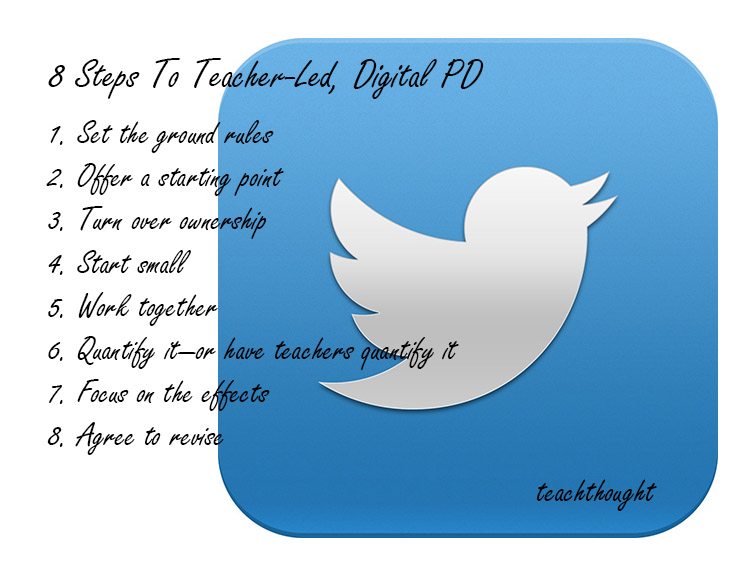What Are The Steps To Teacher-Led, Digital PD?
by TeachThought Staff
Professional development for teachers is a beautiful thing. While many professionals work either in isolation or total stagnation, educators are constantly given new tools to become better at their craft. National-level conferences like ISTE and ASCD, district PD, school PD, professional learning communities, data teams, “PD-style staff meetings,” books, blogs—there are so many incredible resources being updated literally as you read this, that the challenge is more about knowing where to start than finding suitable content.
But beyond any isolated parcel of teacher improvement lies social media. Long the plaything of adults and teens alike, social media has matured to become an incredible learning tool as well, connecting educators to ideas, tools, resources, and most importantly, each other.
Most certified teachers have some amount of formal professional development time they must achieve per semester or year. So, we wondered, why couldn’t “off the clock” PD via twitter, your RSS feed, or your favorite Pinterest peers count towards fulfilling this requirement? Especially as districts struggle to finance more expensive forms of PD in the wake of budget cuts?
Do you want your PD effective, credible with staff, or affordable? Pick two, because finding training that fits all three is a tremendous challenge.
Of course, the idea of rewarding teachers with official PD credit for their time on social media and blogs is naturally disruptive. Schools or districts will seek to “policy” it up to the point where it is indistinguishable from what you do on your own on a nightly basis. (Kind of like formal learning environments tend to do to learning for students.)
You’ll also likely hear how much “garbage” you’ll find on the internet compared to a real PD (the Wikipedia effect), and out the baby goes with the bath water.
With these threats in mind, we wondered if we couldn’t find a compromise that gives schools and districts the kind of structure they need without neutering the experience for teachers. Here’s one take on how it could work.
8 Steps To Teacher-Led, Digital PD
1. Set the ground rules
You could probably call this a policy, but it’s the non-policy policy—just some basic rules and a common language to make sure everyone is starting and finishing at the same point.
For example, you might clarify how many hours of “official PD” “self-directed PD” qualifies for (similar to an elective credit hours). You should also explain how efforts will be qualified and quantified, and explain the big idea—personalizing educator training through self-directed and social media-based professional development.
2. Offer a starting point
Not all teachers will be chomping at the bit, so give them somewhere to start. Maybe a kind of scavenger hunt during a staff meeting (e.g., find 5 apps for struggling readers, two articles on better assessment design, and 10 tips for iPad implementation). Or a list of three blogs and two social media platforms to get started.
3. Turn over ownership
Pair them up, create competitions, publicize it in the local newspaper or school website, share it during conferences, let them speak at school or district PD meetings about their favorite sources, tips for efficiency, and so on. In essence you’re turning much of the ownership over to them–“teacher-centered” learning.
4. Start small
Pilot it in one department or grade level at first. Crawl before you walk.
5. Work together
Have teachers from different schools or districts—even in different states or countries—to not only improve the diversity of resources, but naturally expand professional learning networks in the process.
6. Quantify it—or have teachers quantify it
You could qualify it by hours spent (yuck), content curated (a little better), total resources shared (a tad bit better still), PD presented in person (not bad), alignment between content found and school and district needs (decent), impact on learning performance (nice), or some basic formula of several of these and more.
Then turn that process over to them—crowdsource the recording-keeping with the only expectation being that it’s visible to everyone and simple to update.
7. Focus on the effects
When celebrating effort, offering training, or discussing the process one on one, focus on the effects of the content rather than the medium or the source. The idea here hasn’t changed—improved learning for students via improved teacher efficacy.
8. Agree to revise
Whatever you do the first year will be a trainwreck (compared to the nice and tidy sit-and-get PD). So from the beginning, everyone should be aware that it’s all a work in progress—just like the profession itself.
Perhaps the greatest potential here is in the chance to personalize professional development for teachers. The above ideas are too vague to be considered an exact guide, but an “exact guide” really isn’t possible without ending up with something as top-heavy and standardized as the process it seeks to replace–or at least supplement. Instead focus on the big ideas–personalizing educator training through self-directed and social media-based professional development.
Image attribution flickr user stevegarfield; 8 Steps To Teacher-Led, Digital PD

